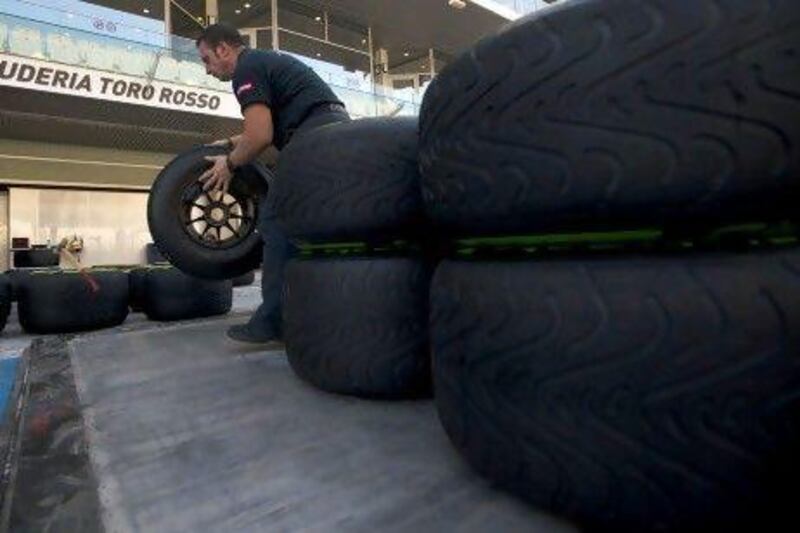The serious business at the Abu Dhabi Grand Prix begins today with the qualifying session that determines the grid for tomorrow's Formula One race.
Qualifying has worn a number of guises in attempts to spice up the action and add unpredictability to the starting line-ups.
The current version, in place since 2006, is divided into three sections and designed to ensure that the cars are on track at regular intervals, with each car having to set at least one competitive lap time in each period. The climax in the fastest 10 cars going out in a 10-minute session where pole position is decided.
A proviso, however, since 2010, is that a driver who competes in what is known in the F1 paddock as "Q3" (qualifier three) must start the race on the tyres on which he qualifies.
This is where things get tricky for the 12 teams, thanks largely to the excellent work of Pirelli, the tyre manufacturers, who supply all the teams in Formula One.
Teams may choose between two tyre compounds in a dry race - the "prime" (hard) tyre and the "option" (soft) tyre.
The rules for F1 dictate each driver in a dry race must use both compound of tyre, meaning they must make at least one pit stop.
The soft tyre is recognisable to viewers by the yellow marking on it. Pirelli's medium tyre is the prime compound selection, and that has a white marking on it.
Where the teams have a headache is that Pirelli, under guidance from F1 chiefs, have designed their tyres to degrade quickly, leading to tyre wear being the biggest variable faced this season.
This now affects how teams approach qualifying. It no longer is only about getting the optimum grid position; it also is about ensuring the availability of enough tyres to survive the race.
The teams have eight sets of Pirellis to last through qualifying and tomorrow's race - four sets of options and four primes.
Bruno Senna, the Williams driver, said that the limited supply meant that it is important to weigh up speed on a Saturday against struggles on a Sunday when the world championship points are won.
"We don't have enough tyres and sometimes during the race you can find yourself in big trouble with tyre wear," the Brazilian said. "There are some races where the tyre degradation is very high and you are not sure if you are to be able to make the race on the used tyres so you try to save it.
"But there are always people who are going to take chances and start as further up as possible."
Tyre strategy has led to a number of exciting races in F1 this season as drivers have fallen back through the field as their grip levels fall.
The option is the fastest tyre, but it wears quickly, leading to earlier pit stops, which could drop the driver into traffic and compromise his pace. The prime is slower over one lap, but has longer durability, with the potential for fewer stops.
This has had the consequence, in qualifying, of teams choosing to conserve tyres for the race.
In India last weekend, Nico Rosberg was fourth-quickest in his Mercedes-GP car in the second part of qualifying. But the German did not set a lap time in the final part of qualifying, never leaving his pit and consigning himself to 10th place on the grid for the race.
Tenth was not a reflection of Rosberg's pace. Had he repeated the time that got him into Q3, he would have started seventh.
But the team chose to sacrifice three slots of grid position for having a choice in which tyres they would use to start the race, like the cars behind him, 11th to 24th.
Paul Hembery, Pirelli's motorsport director, said he understood the approach from the teams, given the situation they are in.
"They are only maximising the regulations that are available to them so you can't criticise them for why they are doing it as there are good technical reasons for it," he said.
Grid positions at the front still matter: the man on pole has won 11 of 17 races this season. But more thought now goes into qualifying for teams who doubt they can challenge for a top spot.
The DRS (drag reduction system) and the Kers (Kinetic energy recovery system) mechanisms have improved the possibility to overtake in F1, meaning the teams at the front, namely Red Bull Racing, McLaren-Mercedes and Ferrari, can be aggressive in qualifying, trusting they can pass slower cars after race-day pit stops.
Rosberg and Mercedes are not the only team to have opted out of setting a lap time in qualifying; much of the grid has chosen tyre preservation at least once this season.
Nico Hulkenberg, the Force India driver, adopted the same approach in Japan last month, and was rewarded in the race with a seventh-place finish.
He defended the tactic. "You need to see the bigger picture," the German said. "If it gives you a chance to get a better result on the Sunday then that is what you have got to do. You have to accept it and it is part of the game."
Hembery added that Pirelli would be happy to suggest solutions if F1 wants a rules change.
He said: "We would prefer to see cars running and we have said if the sport comes to us and asks for a qualifying tyre or other solutions then we will be willing to sit down and discuss them."
Fans should not be alarmed today if, come the end of qualifying, their hero is lounging in the pits twiddling his thumbs. There is method in the apparent madness of not setting a time, but the size of the reward will not be known until 24 hours later.





